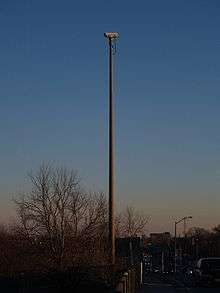Traffic reporting

Traffic Cam
Traffic reporting is the near real-time distribution of information about road conditions such as traffic congestion, detours, and traffic collisions. The reports help drivers anticipate and avoid traffic problems. Traffic reports, especially in cities, may also report on major delays to mass transit that does not necessarily involve roads. In addition to periodic broadcast reports, traffic information can be transmitted to GPS units, smartphones, and personal computers.
Methods of gathering information
There are several methods in use today to gather traffic speed and incident info, ranging from professional reporters, to GPS crowdcrowding to combinations of both methods.
- INRIX uses its network of over 175 million vehicles and devices to gather speed data from mobile phones, trucks, delivery vans, and other fleet vehicles equipped with GPS locator devices including smart phones and Ford SYNC and Toyota Entune and much of Europe, South America, and Africa.
- Google Traffic works by crowdsourcing the GPS information from phone users. By calculating the speed of users along a stretch of road, Google is able to generate a live traffic map.[1] Its subsidiary, Waze, also allows users to report directly via a smartphone app.
- Monitoring police radio frequencies. Some radio stations have agreements with states' highway patrol that permit a direct connection with a law enforcement computer. This enables real-time information gathering of the latest accident reports to highway patrol divisions.
- Many areas have helicopters to overfly accident scenes and other areas of high traffic volume. For example, by the company Global Traffic Network.
- traffic cameras
Methods of transmitting information
- GPS units
- Smartphones
- Radio via voice RDS, and TA
- Electronic road signs
- 5-1-1 traffic information phone line or similar.
- Television and web
Providers
- INRIX develops and distributes INRIX Traffic, a free mobile application, and also provides reporting services to a variety of local television stations.
- NAVTEQ provides data used in a wide range of applications, including automotive navigation systems for many car makers. Most clients use Navteq to provide traffic reports in major metropolitan areas throughout North America. NAVTEQ partners with third-party agencies and companies to provide its services for portable GPS devices made by Garmin, Lowrance, NDrive and web-based applications such as Yahoo! Maps, Bing Maps, and Nokia Maps. XM Satellite Radio and Sirius Satellite Radio use NAVTEQ data to show traffic information on navigation systems.
- Tele Atlas, a subsidiary of TomTom. delivers digital maps and other dynamic content for navigation and location-based services, including personal and in-car navigation systems, and provides data used in a wide range of mobile and Internet map applications.
- Google Maps uses a variety of governmental and private traffic reporting organizations to provide information, along with its Waze subsidiary, which uses crowdsourcing to provide observed traffic conditions.
References
- ↑ Subramanian, Karthik; Srikanth, R. (January 21, 2014). "Now, Apps for Live Traffic Feed". The Hindu.
This article is issued from Wikipedia - version of the 10/7/2016. The text is available under the Creative Commons Attribution/Share Alike but additional terms may apply for the media files.